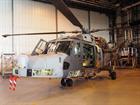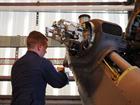Wildcat Engineering Transition
With the introduction of new aircraft and aircraft carriers to the Fleet Air Arm, the normal split of operational ‘grey’ and ‘green’ squadrons has changed dramatically. Being able to operate the Wildcat AH1 (green) on both the land and at sea has seen military and civilian personnel working together to establish an effective aircraft for frontline service.
Since the spring of 2012, HMS Heron has been the home of Wildcat transition. Royal Navy engineers from 847 Naval Air Squadron and a small selection of Army personnel were the first to begin work with the new asset. This initial fielding team had the task of setting up the infrastructure needed to support the new venture.
By Christmas 2012, the Wildcat Fielding Team Army (WFTA) had worked their way up to six aircraft. With limited experience on Wildcat AH1, the battlefield varient, Aircrew and Engineers drew upon their previous experiences from legacy aircraft types to deal with the various procedures, inaccuracies and unforeseen system malfunctions that go hand in hand with any new technology.
From this early start, the WFTA has evolved to form 652 (Wildcat Fielding) Squadron Army Air Corps. Along with their civilian counterparts, Wildcat Contracting Maintenance (WCM), 847 NAS and 652 (WF) Sqn AAC are working to achieve Aircrew and Engineering competency on this new platform. Naturally, with three organisations operating within a relatively new environment, old habits die hard. To counteract this temptation, a philosophy of ‘best practice’ has been adopted throughout, resulting in the practises implemented being the most stringent of all forces.
The collaboration that began more than two years ago between the Royal Navy and the Army will soon come to an end with each side taking their share of the aircraft in early 2015. 652 (WF) Sqn AAC will convert the Army squadrons to the Wildcat whilst 847 NAS will field the aircraft as the first operational Wildcat squadron. As WCM has achieved more, each side will operate their own maintenance with a pool of serviceable aircraft. Although the working routines and operational environments will be different, all three organisations will still function out of the same hangars whilst continuing to work from similar Aircraft Engineering Standing Orders.
Although the Wildcat Mk1 is similar in appearance to the various Lynx marks, the internal workings are vastly different. The structure is now a monolithic airframe milled from one piece of metal, allowing the aircraft to benefit from an increase in strength and reduction in airframe weight. The new avionics equipment has been introduced to reduce pilot workload, this is achieved by allowing mission planning to take place on the ground via the tactical processor (the brains behind the system). The tactical processor works in conjunction with the Integrated Display Units and Security Enhanced Data Transfer Unit to allow the aircrew to layer the vital information over maps, enabling better situational awareness.
As with previous aircraft types, expertise can only be gained over time, but thanks to the hard work of the fielding teams, 847 NAS will be in a good starting position when the squadron stands up on April 2015 and takes on the Very High Readiness responsibility.


